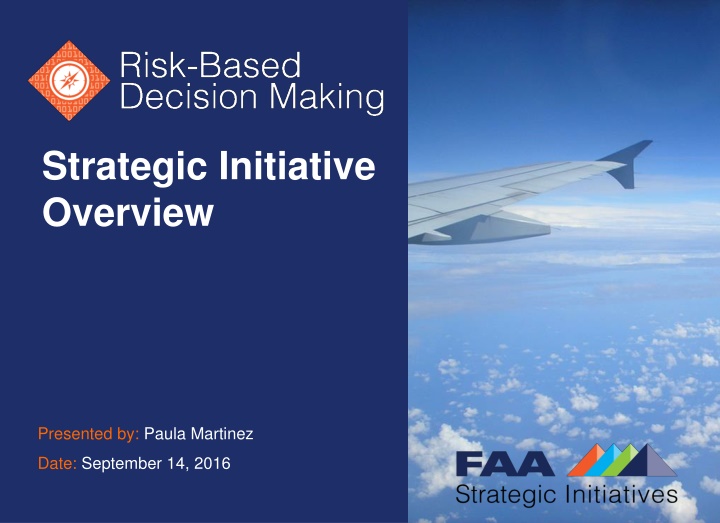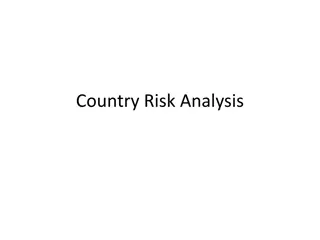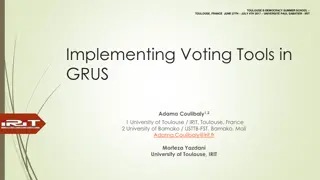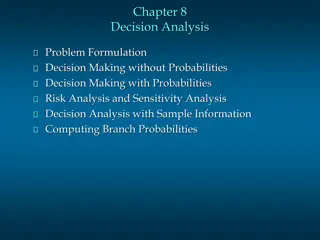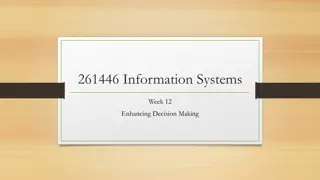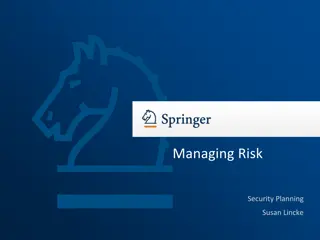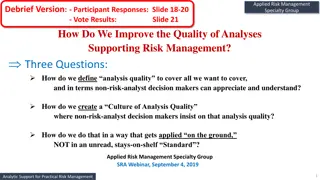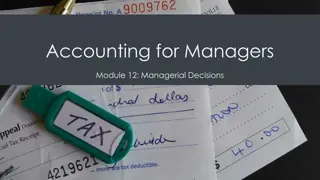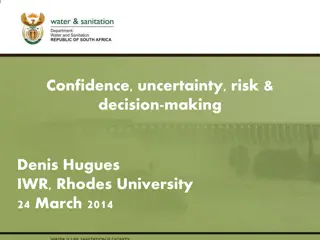Risk-Based Decision Making Strategic Initiative Overview
Providing an overview of the Risk-Based Decision Making Strategic Initiative, presenting defined concepts like SSP, SMS, and Risk-Based Decision Making, aiming to improve safety by integrating regulations, activities, and data-informed approaches. The initiative focuses on making smarter, system-level, risk-based decisions to address emerging safety risks effectively.
Download Presentation

Please find below an Image/Link to download the presentation.
The content on the website is provided AS IS for your information and personal use only. It may not be sold, licensed, or shared on other websites without obtaining consent from the author.If you encounter any issues during the download, it is possible that the publisher has removed the file from their server.
You are allowed to download the files provided on this website for personal or commercial use, subject to the condition that they are used lawfully. All files are the property of their respective owners.
The content on the website is provided AS IS for your information and personal use only. It may not be sold, licensed, or shared on other websites without obtaining consent from the author.
E N D
Presentation Transcript
Risk-Based Decision Making Strategic Initiative Overview Strategic Initiative Overview Presented by: Paula Martinez Date: September 14, 2016
Briefing Structure 1: SSP, SMS, and Risk-Based Decision Making Initiative 2: Risk-Based Decision Making
SSP, SMS and Risk-Based Decision Making Initiative 1 SSP, SMS, and Risk-Based Decision Making Initiative
SSP, SMS, and Risk-Based Decision Making Initiative Defined State Safety Program (SSP): An integrated set of regulations and activities aimed at improving safety. Safety Management System (SMS): A formal, top-down, organization-wide approach to managing safety risk and assuring the effectiveness of safety risk controls. It includes systematic procedures, practices, and policies for the management of safety risk. Risk-Based Decision Making Initiative: One of the FAA Administrator s four strategic initiatives identified as top priorities over the next five years. The goal of this initiative is to ensure that safety risk is systematically included as part of the equation when decisions are made. Risk-Based Decision Making September 2016 3
Overview of Safety Management Activities The U.S. SSP provides the overarching framework for our safety system The FAA SMS provides the details of our approach to safety management, showing how we will meet most of the tenets of the U.S. SSP The Risk-Based Decision Making Initiative enables the FAA SMS by putting in place the tools and processes to proactively address emerging safety risk using consistent, data-informed approaches to support system-level, risk- based decisions Risk-Based Decision Making September 2016 4
2: Risk-Based Decision Making 2 Risk-Based Decision Making
AOA Strategic Initiatives Risk-Based Decision Making Build on SMS principles to address emerging safety risk by using consistent, data- informed approaches to make smarter, system-level, risk- based decisions NAS Lay the foundation for the NAS of the future by accelerating prioritized NextGen benefits, integrating new user entrants, and delivering more efficient, streamlined services Foundation for Aviation System of the Future Global Leadership Improve safety, air traffic efficiency, and environmental sustainability across the globe through an integrated, data- informed approach that shapes global standards and enhances collaboration and harmonization Workforce of the Future Prepare FAA s human capital for the future, by identifying, recruiting, and training a workforce with the leadership, technical, and functional skills to ensure the U.S. has the world s safest and most productive aviation sector Risk-Based Decision Making September 2016 6
Risk-Based Decision Making Vision: Decisions are made with a full understanding of the safety impacts on the aerospace system High Quality and Better Access Systematic and Consistent Use Better-Informed Decisions Risk-Based Decision Making September 2016 7
Risk-Based Decision Making Sub-Initiatives and Activities Improve standardization, data access, and modeling integration Taxonomies Modeling Greater data access competencies and skills 1 Hazard tracking Safety data and risk analysis Enhance decision-making process Identify safety hazards of planned changes Identify and mitigate safety risk of existing cross-organizational issues Changes to FAA SMS decision-making and governance structure 2 Evolve the Safety Oversight Model Leverage industry s use of safety management principles; exchange safety management lessons learned and best practices 3 Transition to Safety Management Operationalize the outputs of the RBDM activities Focus on conducting safety risk assessments on safety Issues and planned changes
Sub-Initiative #1: Improve Standardization, Data Access, & Modeling Integration
Sub-Initiative 1 Overview Obtain greater access to sources of data and improve the ability to share data both internally and external to the FAA Safety analysts will use data sources with taxonomies in place to connect the systems to one another, ensuring that the data is consistent and reliable across the FAA Ability to look across data sources to identify potential safety issues that cross organizational boundaries Establish an agency-wide tool to track hazards and mitigation outcomes Augment existing safety risk management efforts and ensure that the FAA has a consistent means of tracking and reporting the status of these efforts, both within and across organizational boundaries Enhance FAA decision making and enable executives and managers to better focus organizational resources on areas of greatest safety risk Risk-Based Decision Making September 2016 10
Sub-Initiative 1 Accomplishments Taxonomies Developed a high-level safety taxonomy and draft hazard taxonomy for the agency Safety Data and Risk Analysis Competencies and Skills Documented the as-is and to-be states for the operational research analysts; used the information to deliver a Job Task Analysis (JTA) Developed a transition plan to integrate this JTA into the Human Resource function so that it can be used in the hiring process Greater Data Access and Standardization Established an Interim Safety Community of Interest that is working on building an initial set of safety databases and taxonomies that are of high value to safety analysts across the FAA This prototype builds on and incorporates in the work already completed on creating standardized taxonomies and determining the skills needed for safety analysts Hazard Tracking On March 25, 2016, the FAA launched the Hazard Identification, Risk Management and Tracking (HIRMT) tool, a web-based software tool to capture, manage, and report on safety issues affecting multiple FAA organizations Risk-Based Decision Making September 2016 11
Sub-Initiative 1 Next Steps Greater Data Access and Standardization Establish a permanent safety data and analysis team to standardize and integrate safety data at the agency level Complete transition of the Interim Safety Community of Interest to a permanent safety data and analysis team Hazard Tracking Implement system enhancements to support interconnectivity with relevant data systems Risk-Based Decision Making September 2016 12
Sub-Initiative #2: Enhance Decision-Making Process
Sub-Initiative 2 Overview Develop and implement processes to identify and mitigate the safety risk of cross-organizational issues that are found to exist as a result of incidents in the system Design and implement changes to FAA SMS decision-making and governance structure Risk-Based Decision Making September 2016 14
Sub-Initiative 2 Accomplishments Significant Safety Issues Developed an agency-wide SSI identification process to identify emerging cross-cutting, safety issues Transitioned work to Safety Performance Management Branch Policy/Process Updates Teams provided a briefing to the FAA SMS Committee on recommendations for the revision of existing policies, guidance and processes based on lessons learned through their activities This led to the update to 8000.369 as well as the update that is currently under way to FAA Order 8040.4A, Safety Risk Management Safety Collaboration Team Updated charter for Safety Collaboration Team to be a standing team under the FAA SMS Committee, focusing on overseeing the safety analysis of pre-planned NAS changes Coordinated the safety assessment on test case Charters FAA SMS Committee charter was updated to more accurately reflect the group s safety management responsibilities and created a charter for the FAA SMS Executive Council to document their safety management responsibilities and interactions These charters are important in clearly outlining the governance of safety management in the agency Risk-Based Decision Making September 2016 15
Sub-Initiative 2 Next Steps Work from Sub-Initiative 2 completed Add-on work moved to Transition to Safety Management section Risk-Based Decision Making September 2016 16
Sub-Initiative #3: Evolve the Safety Oversight Model
Sub-Initiative 3 Overview Evolve the FAA oversight model to leverage industry s use of safety management principles, and exchange safety management lessons learned and best practices Cooperate with industry to actively manage risk in the aerospace system Generate sufficient data to support a full safety risk management process including rulemaking and operational assessment of safety risk controls Increase its efficiency and effectiveness of the FAA oversight workforce Risk-Based Decision Making September 2016 18
Sub-Initiative 3 Accomplishments Oversight Terminology, Current State, Best Practices, and Recommendations Developed agency-wide dictionary for standardized oversight terminology Documented current FAA regulatory oversight processes and tools and common threads among them Documented Safety Regulatory Best Practices Developed recommendations for future oversight approach Compliance Philosophy The FAA Administrator signed the FAA Compliance Philosophy Order on June 26 and introduced the new philosophy at the FAA Town Hall Meeting on July 29 The FAA Administrator signed the Enforcement Order 2150.3B Change 3 on September 3, 2015, supporting the implementation of the FAA Compliance Philosophy All affected employees were trained on the Compliance Philosophy Risk-Based Decision Making September 2016 19
Sub-Initiative 3 Next Steps Oversight Philosophy Order Explore reduction of duplicative activities and concepts associated with integrated, coordinated oversight of certificate holders with multiple certificate types Explore agency-wide data management requirements and concepts that support the FAA Oversight Philosophy and risk-based decision making Risk-Based Decision Making September 2016 20
Transition to Safety Management (SM): Safety Performance Management
Transition to SM Overview Integrate Risk-Based Decision Making Strategic Initiative outputs into U.S. SSP/ FAA SMS Transition from strategic to operational as the Strategic Initiative comes to a close over the next few years Risk-Based Decision Making September 2016 22
Transition to SM Accomplishments Safety Performance Management Stood up a new Safety Performance Management Branch to manage safety assessments and ensure issues of concerns are addressed and safety performance is improved Published guidance for conducting safety risk assessments on issues that cross multiple organizations and seek involvement management and FAA stakeholders Significant Safety Issues Established repeatable processes to identify safety issues Process updated in to incorporate in lessons learned Conducted test case assessment Risk-Based Decision Making September 2016 23
Transition to SM Next Steps Improve safety issue identification process and conduct assessments Update FAA SRM Policy and Guidance based on lessons learned Risk-Based Decision Making September 2016 24
